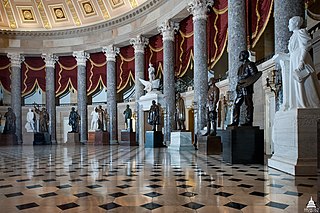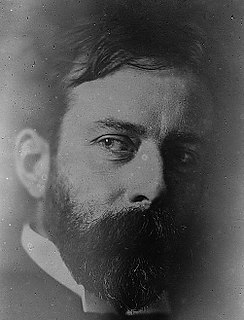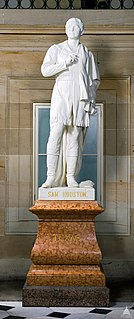
Frances Elizabeth Caroline Willard was an American educator, temperance reformer, and women's suffragist. Willard became the national president of Woman's Christian Temperance Union (WCTU) in 1879 and remained president until her death in 1898. Her influence continued in the next decades, as the Eighteenth (Prohibition) and Nineteenth Amendments to the United States Constitution were adopted. Willard developed the slogan "Do Everything" for the WCTU, encouraging members to engage in a broad array of social reforms through lobbying, petitioning, preaching, publishing, and education. During her lifetime, Willard succeeded in raising the age of consent in many states, as well as passing labor reforms including the eight-hour work day. Her vision also encompassed prison reform, scientific temperance instruction, Christian socialism, and the global expansion of women's rights.

National Statuary Hall is a chamber in the United States Capitol devoted to sculptures of prominent Americans. The hall, also known as the Old Hall of the House, is a large, two-story, semicircular room with a second story gallery along the curved perimeter. It is located immediately south of the Rotunda. The meeting place of the U.S. House of Representatives for nearly 50 years (1807–1857), after a few years of disuse in 1864 it was repurposed as a statuary hall; this is when the National Statuary Hall Collection was established. By 1933 the collection had outgrown this single room, and a number of statues are placed elsewhere within the Capitol.

The National Statuary Hall Collection in the United States Capitol is composed of statues donated by individual states to honor persons notable in their history. Limited to two statues per state, the collection was originally set up in the old Hall of the House of Representatives, which was then renamed National Statuary Hall. The expanding collection has since been spread throughout the Capitol and its Visitor's Center.

Lorado Zadok Taft was an American sculptor, writer and educator. His 1903 book, The History of American Sculpture, was the first survey of the subject and stood for decades as the standard reference. He has been credited with helping to advance the status of women as sculptors.

Helen Farnsworth Mears was an American sculptor.
Robert E. Lee is a bronze sculpture commemorating the general of the same name by Edward Virginius Valentine, installed in the crypt of the United States Capitol as part of the National Statuary Hall Collection. The statue was gifted by the commonwealth of Virginia in 1909.

Sakakawea is a monumental sized bronze sculpture created by Leonard Crunelle. It was dedicated on October 13, 1914 and stands on the grounds of the North Dakota State Capitol in Bismarck, North Dakota.

Ethan Allen is a marble sculpture of Ethan Allen by Larkin Goldsmith Mead.

Stephen F. Austin by Elisabet Ney is a statue of Texas founder Stephen F. Austin which is part of the National Statuary Hall Collection in the United States Capitol in Washington, D.C. It is one of the two statues in the National Statuary Hall representing Texas; the other, of Sam Houston, is also by Ney. Both statues were unveiled in Washington, D.C. in 1905.

Sam Houston is a statue of Sam Houston originally modeled in 1892 by Elisabet Ney which resides in the National Statuary Hall Collection in the US Capitol, Washington, D.C. as one of the two statues from Texas; the other statue from Texas, the Stephen F. Austin statue, is also by Ney. Another carving of Sam Houston is displayed in the Texas State Capitol.

Norman Borlaug, or Dr. Norman E. Borlaug, is a bronze sculpture depicting the American agronomist and humanitarian of the same name by Benjamin Victor, installed in the United States Capitol's National Statuary Hall, in Washington, D.C., as part of the National Statuary Hall Collection. The statue was donated by the U.S. state of Iowa in 2014, and replaced one depicting James Harlan, which the state had gifted in 1910.

Helen Keller is a bronze sculpture depicting the American author and political activist of the same name by Edward Hlavka, installed in the United States Capitol Visitor Center's Emancipation Hall, in Washington, D.C., as part of the National Statuary Hall Collection. The statue was gifted by the U.S. state of Alabama in 2009, and replaced one depicting Jabez Lamar Monroe Curry, which had been donated in 1908.

John M. Clayton is a 1934 marble sculpture depicting the American lawyer and politician of the same name by Bryant Baker, installed in the United States Capitol, in Washington D.C., as part of the National Statuary Hall Collection. It is one of two statues donated by the state of Delaware The statue was accepted in the collection by Robert G. Houston on June 6, 1934.
Philo T. Farnsworth is a bronze sculpture depicting the American inventor and television pioneer of the same name by James Avati, installed at the United States Capitol Visitor Center's Emancipation Hall, in Washington, D.C., as part of the National Statuary Hall Collection. The statue was gifted by the U.S. state of Utah in 1990.

Andrew Jackson is a 1928 bronze sculpture of Andrew Jackson by Belle Kinney Scholz and Leopold Scholz, installed in the United States Capitol, in Washington D.C., as part of the National Statuary Hall Collection. It is one of two statues donated by the state of Tennessee. The statue was accepted in the collection by Senator Kenneth McKellar on April 16, 1928.

John James Ingalls is a 1905 marble sculpture of the politician of the same name by Charles Henry Niehaus, installed in the United States Capitol, in Washington D.C., as part of the National Statuary Hall Collection. It is one of two statues donated by the state of Kansas. The statue was accepted in the collection by Senator Arthur P. Gorman on January 21, 1905.

John Hanson is a bronze statue by Richard E. Brooks of John Hanson, installed in the United States Capitol, in Washington, D.C., as part of the National Statuary Hall Collection. It is one of two statues donated by the state of Maryland.

Oliver P. Morton is a 1900 marble statue of Oliver P. Morton by Charles Henry Niehaus installed in the United States Capitol, in Washington, D.C., as part of the National Statuary Hall Collection. It is one of two statues donated by the state of Indiana. The statue was accepted into the collection on April 14, 1900 by Indiana Senator Albert J. Beveridge.,
James Shields is an 1893 bronze sculpture of James Shields by Leonard Volk, installed in the United States Capitol, in Washington, D.C., as part of the National Statuary Hall Collection. It is one of two statues donated by the state of Illinois. The sculpture was unveiled by Senator Shelby Moore Cullom of Illinois on December 6, 1893.
















